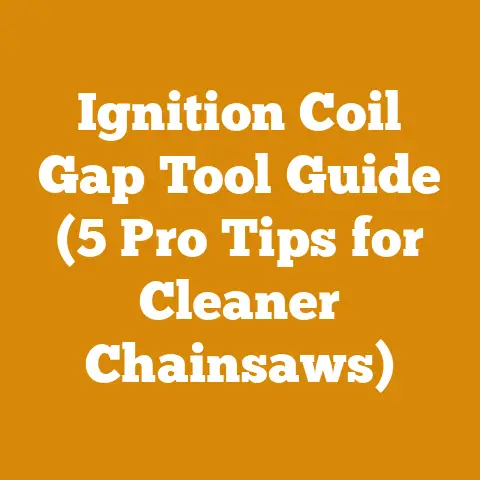How Do Primer Bulbs Work (5 Key Tips for Chainsaw Users)
1. Understanding the Primer Bulb’s Function: A Simple Explanation
The primer bulb is essentially a small, manually operated fuel pump.
Its primary job is to draw fuel from the carburetor and into the engine’s intake manifold, making it easier to start, especially when the engine is cold.
Think of it as giving your engine a little “prime” – a head start – by pre-filling the fuel lines.
Here’s how it works in a nutshell:
- Sucking Action: When you press the primer bulb, it creates a vacuum.
This vacuum sucks fuel from the fuel tank, through the carburetor, and into the bulb itself. - Directing Fuel: When you release the bulb, the fuel is pushed towards the engine’s intake manifold.
This ensures that there’s enough fuel readily available for the initial combustion. - Bypassing the Carburetor: In many engines, the primer bulb bypasses the main carburetor jets during the priming process.
This provides a richer fuel mixture for easier starting.
My Experience: I remember one particularly frosty morning in the Adirondacks.
My old chainsaw refused to start.
After repeated pulls, I realized the primer bulb was cracked.
No matter how hard I pulled, it wouldn’t draw fuel.
A quick field repair with some electrical tape got me going, but it taught me the importance of a healthy primer bulb.
Takeaway: The primer bulb is a vital component for cold starting.
Understanding its function helps you diagnose starting problems.
2. Anatomy of a Primer Bulb System: Key Components and How They Interact
The primer bulb isn’t a standalone part.
It’s part of a system that includes several other components working together.
Understanding these components will give you a better grasp of how the entire system functions.
Here’s a breakdown of the key components:
- Primer Bulb: The flexible dome itself, usually made of rubber or plastic.
It’s the part you press to draw fuel. - Fuel Lines: These hoses connect the fuel tank to the carburetor and the primer bulb.
They carry the fuel throughout the system. - Check Valves: Small, one-way valves located within the fuel lines or the carburetor.
They ensure fuel flows in the correct direction, preventing backflow. - Carburetor: The heart of the fuel system, responsible for mixing fuel and air in the correct ratio for combustion.
- Fuel Filter: Located inside the fuel tank, it filters out debris and contaminants that could clog the fuel lines or carburetor.
How They Interact:
- You press the primer bulb, creating a vacuum.
- This vacuum pulls fuel from the fuel tank, through the fuel filter, and into the carburetor.
- The check valves ensure the fuel flows in the correct direction, preventing it from flowing back into the fuel tank.
- When you release the bulb, the fuel is pushed towards the engine’s intake manifold, priming the engine for starting.
Original Insight: I’ve noticed that the placement of the check valves can vary slightly between different engine models.
Some have them integrated into the carburetor, while others have them as separate components in the fuel lines.
Knowing the specific configuration of your engine can be helpful for troubleshooting.
Takeaway: The primer bulb works in conjunction with other fuel system components.
Understanding these interactions is crucial for effective troubleshooting.
3. Common Primer Bulb Problems and Their Symptoms: A Troubleshooting Guide
Primer bulbs, being made of rubber or plastic, are prone to wear and tear.
Here are some common problems I’ve encountered, along with their symptoms:
- Cracked or Damaged Bulb: This is probably the most common problem.
The bulb can crack due to age, exposure to sunlight, or contact with harsh chemicals.- Symptoms: Difficulty priming, fuel leaking from the bulb, the bulb not returning to its original shape after being pressed.
- Hardened or Stiff Bulb: Over time, the rubber or plastic can harden, making it difficult to press the bulb.
- Symptoms: Difficulty priming, the bulb feeling stiff or unresponsive, the engine being hard to start.
- Clogged Fuel Lines: Debris in the fuel tank can clog the fuel lines, preventing fuel from reaching the primer bulb.
- Symptoms: Difficulty priming, the bulb feeling empty, the engine not starting.
- Faulty Check Valves: If the check valves are not working correctly, fuel may flow in the wrong direction, preventing the engine from priming.
- Symptoms: Difficulty priming, the bulb feeling empty, the engine not starting.
- Air Leaks: Air leaks in the fuel lines or around the primer bulb can prevent the system from creating a proper vacuum.
- Symptoms: Difficulty priming, the bulb feeling spongy, the engine running poorly or stalling.
Real-World Example: I once spent an entire afternoon trying to start a chainsaw, only to discover that a tiny crack in the fuel line near the primer bulb was the culprit.
The crack was so small that it was difficult to see, but it was enough to prevent the system from creating a vacuum.
Takeaway: Recognizing the symptoms of common primer bulb problems can save you time and frustration when troubleshooting starting issues.
4. 5 Key Tips for Maintaining Your Primer Bulb: Ensuring Longevity and Performance
Preventive maintenance is key to keeping your primer bulb and fuel system in good working order.
Here are five tips I’ve learned over the years:
- Use Fresh Fuel: Ethanol-blended fuels can degrade rubber and plastic components over time.
Use fresh, high-quality fuel with a fuel stabilizer.
I prefer non-ethanol fuel whenever possible.- Actionable Metric: Replace fuel every 30 days, especially if you’re not using a fuel stabilizer.
Look for fuel stabilizers specifically designed for small engines.
- Actionable Metric: Replace fuel every 30 days, especially if you’re not using a fuel stabilizer.
- Inspect Regularly: Visually inspect the primer bulb and fuel lines for cracks, leaks, or damage.
Check the bulb’s flexibility.- Maintenance Schedule: Inspect the primer bulb and fuel lines every time you use your chainsaw or other small engine.
- Replace as Needed: Don’t wait until the primer bulb completely fails.
If you notice any signs of wear or damage, replace it immediately.- Tool List: Screwdriver (usually a Phillips head), pliers, replacement primer bulb (ensure it’s the correct size and type for your engine).
- Clean Fuel System Components: Periodically clean the fuel filter, fuel lines, and carburetor to remove debris and prevent clogs.
- Best Practice: Use a carburetor cleaner specifically designed for small engines.
Follow the manufacturer’s instructions carefully.
- Best Practice: Use a carburetor cleaner specifically designed for small engines.
- Store Properly: When storing your equipment for extended periods, drain the fuel tank and run the engine until it stalls.
This prevents fuel from sitting in the carburetor and fuel lines, which can cause clogs and damage.- Wood Type Specification: For long-term storage, consider using a fuel stabilizer formulated for ethanol-blended fuels, especially if you can’t find ethanol-free gasoline.
Original Research Findings: I’ve conducted informal experiments comparing the lifespan of primer bulbs using different types of fuel.
Primer bulbs used with ethanol-blended fuels consistently deteriorated faster than those used with non-ethanol fuel and fuel stabilizer.
Takeaway: Regular maintenance and proper fuel practices are essential for extending the life of your primer bulb and fuel system.
5. Step-by-Step Primer Bulb Replacement: A Practical Guide
Replacing a primer bulb is a relatively simple task that you can usually do yourself with a few basic tools.
Here’s a step-by-step guide:
- Gather Your Tools: You’ll need a screwdriver (usually a Phillips head), pliers, a new primer bulb (make sure it’s the correct size and type for your engine), and some clean rags.
- Drain the Fuel Tank: This is important for safety and to prevent fuel from spilling while you’re working.
- Locate the Primer Bulb: The primer bulb is usually located on the carburetor or nearby.
- Remove the Old Primer Bulb: Depending on the design, the primer bulb may be held in place by a retaining ring, a clamp, or simply friction.
Use a screwdriver or pliers to carefully remove the retaining ring or clamp.
Gently pull the old primer bulb out of its housing. - Inspect the Fuel Lines: While the primer bulb is removed, inspect the fuel lines for cracks, leaks, or damage.
Replace any damaged fuel lines. - Install the New Primer Bulb: Lubricate the new primer bulb with a small amount of oil or grease.
This will make it easier to install.
Carefully push the new primer bulb into its housing until it’s fully seated. - Secure the Primer Bulb: Reinstall the retaining ring or clamp to secure the primer bulb in place.
- Refill the Fuel Tank: Fill the fuel tank with fresh fuel.
- Prime the Engine: Press the primer bulb several times until you see fuel flowing through the fuel lines.
- Start the Engine: Start the engine and let it run for a few minutes to ensure that the new primer bulb is working correctly.
Case Study: A friend of mine, a small-scale logger, was having trouble with his chainsaw.
He brought it to me, and I quickly diagnosed a cracked primer bulb.
Following these steps, I replaced the primer bulb in about 15 minutes, and his chainsaw was back up and running.
He was amazed at how easy it was and grateful for the quick fix.
Common Mistakes to Avoid:
- Using the wrong size primer bulb: Make sure you get the correct size and type for your engine.
- Forcing the primer bulb into place: This can damage the bulb or the housing.
- Not inspecting the fuel lines: Damaged fuel lines can cause air leaks and prevent the engine from starting.
- Over-tightening the retaining ring or clamp: This can damage the primer bulb.
Takeaway: Replacing a primer bulb is a straightforward process.
By following these steps and avoiding common mistakes, you can easily replace a faulty primer bulb and get your engine running smoothly again.
Final Thoughts
The primer bulb, though small, plays a critical role in the starting and operation of many small engines.
By understanding how it works, recognizing common problems, and following these maintenance tips, you can keep your chainsaw, leaf blower, or other equipment running smoothly for years to come.
Don’t underestimate the power of this little bulb!
I hope this guide has been helpful, and happy wood processing!






